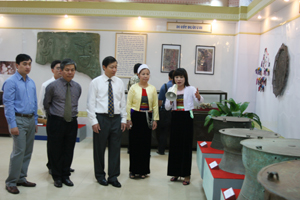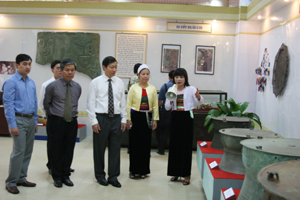
(HBO) - Not only is the place to preserve, store, display, exploit and promote the values of national cultural heritage, the Provincial Museum is also a place to store a lot of heroic memories of the war against the French colonialists and the American empire of our provincial troops and people through the artifacts.
The provincial Museum staff is checking the body of French tank of and the wing of American B52 aircraft at the yard of the Department of culture, Sports & Tourism.
Mr. Nguyen Thi Thi, the Director of the Provincial Museum says currently there are more than 11,000 documents and artifacts about Hoa Binh culture including over 100 documents and artifacts about the war against French colonialism and American imperialism at the Provincial Museum. These are the historical evidences of a period of the fierce struggle, the great sacrifice, the brave spirit, the cunning and the creativity in combat of our troops and people.
Now the artifacts with small volumes are stored and preserved in the artifact warehouse of the Museum, the artifacts with large volumes are kept outdoors such as the body of the battleship, the body of the tank, the pieces, the wing and the shaft of aircraft and so on.
In order for people and visitors to learn about Hoa Binh culture, about the milestones, the historical periods of our troops and people in the wars, the Provincial Museum has opened many exhibitions with a variety of rich themes.
Due to the Museum's small gallery space, most of the museum's galleries have been shown according to their own themes and titles. In addition, the Provincial Museum has cooperated with the other localities to organize the mobile displays at relics sites in the province and other provinces on the anniversaries and major holidays of the nation.
Through the original materials and artifacts, it is an opportunity for the local people and tourists to visit and learn about Hoa Binh culture and important historical landmarks of the province since its establishment, the revolts of people of the ethnic groups in the province before the Party. They can also learn about the revolutionary movement of the province in the period of the general uprising, the war against the French colonialists and the American empire of the peoples in the province, the typical artifacts with the precious antiquities of the province. Through the artifacts stored at the Provincial Museum, it helps today's young generation understand, respect and be proud of the struggle of their fatherland.
With an increasingly vibrant and widespread emulation movement aimed at building cultured residential areas and cultured families, Yen Thuy District has been making steady progress toward improving both the material and spiritual well-being of its people, while fostering a civilized, prosperous, beautiful, and progressive community.
Once lacking recreational spaces and community facilities, Residential Group 2 in Quynh Lam Ward (Hoa Binh City) has recently received attention for the construction of a new, spacious, and fully equipped cultural house. The project followed the model of state support combined with public contributions in both labor and funding.
The "All people unite to build cultural life" movement, which has been effectively integrated with Kim Boi district’s socio-economic development goals, is fostering a lively spirit of emulation across local residential areas, hamlets, villages, public agencies, and enterprises. In addition, through the initiative, traditional cultural values are being preserved and promoted, while community solidarity and mutual support in poverty reduction and economic development are being strengthened.
A working delegation of the Hoa Binh provincial People’s Committee led by its Permanent Vice Chairman Nguyen Van Toan on June 11 inspected the progress of a project to build the Mo Muong Cultural Heritage Conservation Space linked to tourism services in Hop Phong commune, Cao Phong district.
Born and growing in the heroic land of Muong Dong, Dinh Thi Kieu Dung, a resident in Bo town of Kim Boi district, in her childhood was nurtured by the sweet lullabies of her grandmother and mother. These melodies deeply imprinted on her soul, becoming an inseparable part of her love for her ethnic group's culture. For over 20 years, this love for her hometown has driven Dung to research, collect, and pass down the cultural values of the Muong people to future generations.
In the final days of May, the Ethnic Art Troupe of Hoa Binh Province organized performances to serve the people in remote, mountainous, and particularly disadvantaged areas within the province. These were not just ordinary artistic shows, but they were the meaningful journeys aimed at spreading cultural values, enhancing the spiritual life of the people and contributing to the preservation of ethnic minority cultural identities.



